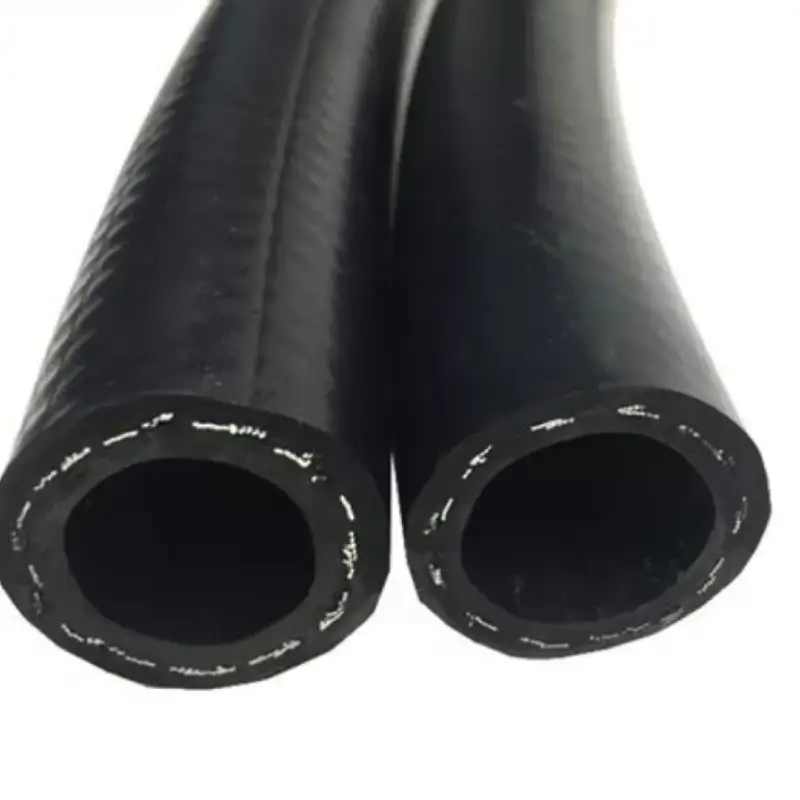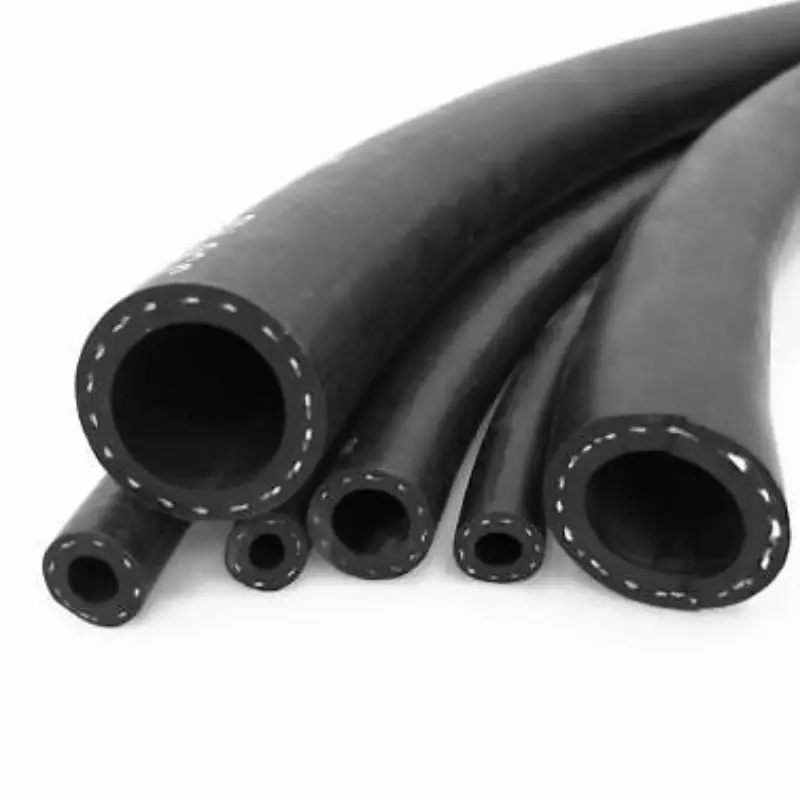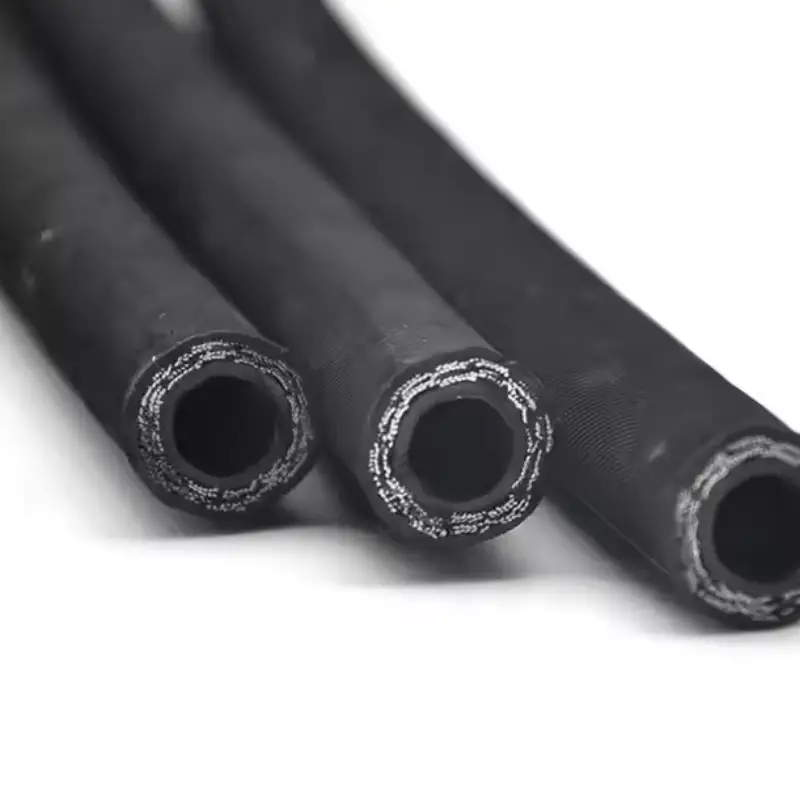Smooth Cover Hydraulic Hose
We can manufacture smooth cover hydraulic hoses with a variety of outer covers, including smooth options. These hoses provide excellent abrasion resistance and a clean, professional appearance, making them ideal for applications where hose appearance is important or where abrasion resistance is critical.

Smooth Cover Hydraulic Hose
We can customize smooth cover hydraulic hoses to meet your specific needs. We offer a wide range of options, including different hose materials, reinforcement types, and outer cover colors and finishes. Our smooth cover hoses provide excellent abrasion resistance and a professional appearance, making them suitable for a variety of applications.
Smooth Cover Hydraulic Hose vs Wrapped Cover
Smooth Cover Hydraulic Hose

Smooth cover hoses feature a continuous, uninterrupted outer surface. This design offers several advantages:
- Enhanced Abrasion Resistance: The smooth surface minimizes the risk of snagging or catching on rough surfaces or edges, improving durability in demanding applications.
- Improved Routing: Smooth hoses are generally easier to route and install, particularly in confined spaces or complex systems, as they are less likely to get caught or snagged.
- Enhanced Aesthetics: Smooth cover hoses offer a cleaner, more professional appearance compared to wrapped cover hoses.
Wrapped Cover Hydraulic Hose

Wrapped cover hoses have a characteristic “wrapped” or “corded” appearance due to the hydraulic hose manufacturing process, where layers of fabric are wrapped around the hose core during production.
- Cost-Effective: Wrapped cover hoses are generally more cost-effective to manufacture.
- Good Abrasion Resistance: While not as smooth as smooth cover hoses, wrapped cover hoses still offer good abrasion resistance and durability.
- Traditional Construction: This is a traditional method of hose construction with a proven track record.
Smooth Cover Hydraulic Hos FAQs
How to make smooth cover hydraulic hose?
The manufacturing process for smooth cover hydraulic hoses involves several key steps:
Inner Tube Extrusion: The inner tube, typically made of rubber or synthetic materials, is extruded onto a mandrel. This creates a continuous, hollow tube with the desired inner diameter.
Reinforcement Layer Application: Reinforcement layers, such as wire braids or textile layers, are applied over the inner tube. These layers provide strength, flexibility, and pressure resistance to the hose.
Outer Cover Extrusion: This is where the smooth cover is applied. A continuous sheath of rubber or other suitable material is extruded over the reinforced hose assembly.
- Key to Smoothness:
- Careful Extrusion: Precise control of the extrusion process is crucial to ensure a smooth, consistent, and defect-free outer cover.
- Mandrel Quality: The quality and smoothness of the mandrel used in the extrusion process significantly impact the final surface finish of the hose.
- Material Selection: The choice of outer cover material is critical. Materials that are easily extruded and have good flow characteristics are essential for achieving a smooth surface.
- Curing and Finishing:
- The hose assembly is then cured in a controlled environment to ensure the proper bonding of the various layers.
- After curing, the hose may undergo additional finishing processes such as trimming, testing, and marking.
This process results in a hydraulic hose with a smooth, continuous outer surface, offering enhanced abrasion resistance, improved routing, and a more aesthetically pleasing appearance.
Note: This is a general overview of the manufacturing process. Specific techniques and materials may vary depending on the manufacturer and the specific requirements of the hose.
What are benefits of smooth cover hydraulic hose?
Smooth cover hydraulic hoses offer several key benefits:
Enhanced Abrasion Resistance: The smooth, continuous outer surface minimizes the risk of snagging or catching on rough surfaces, edges, or other components within the system. This significantly reduces the likelihood of wear and tear, extending the hose’s lifespan and minimizing the risk of premature failure.
Improved Routing and Installation: The smooth surface allows for easier routing and installation, particularly in confined spaces or complex systems. The hose glides more easily through obstacles, reducing the risk of kinking or damage during installation.
Enhanced Aesthetics: Smooth cover hoses offer a cleaner, more professional appearance compared to wrapped cover hoses. This can be particularly important in applications where aesthetics are a consideration, such as in mobile equipment or in applications where the hose is visible to the end-user.
Reduced Risk of Contamination: The smooth surface minimizes the accumulation of dirt, debris, and other contaminants, which can potentially enter the hydraulic system and cause damage.
By selecting smooth cover hydraulic hoses, you can enhance system reliability, improve ease of installation, and maintain a professional appearance while minimizing the risk of damage and downtime.
What are differences between smooth cover hydraulic hose and wrapped cover?
Smooth Cover Hydraulic Hose
Smooth cover hoses are manufactured using a continuous extrusion process for the outer layer. This creates a seamless, uniform surface with no visible seams or wraps. This manufacturing method results in several key advantages:
- Enhanced Abrasion Resistance: The smooth surface minimizes the risk of snagging or catching on rough surfaces or edges, significantly improving durability and reducing wear and tear.
- Improved Routing: Smooth hoses are easier to route and install, particularly in confined spaces or complex systems.3 The smooth surface minimizes friction and allows for smoother movement within the system.4
- Enhanced Aesthetics: Smooth cover hoses offer a cleaner, more professional appearance compared to wrapped cover hoses.5 This can be particularly important in applications where aesthetics are a consideration, such as in mobile equipment or in applications where the hose is visible to the end-user.
Wrapped Cover Hydraulic Hose
Wrapped cover hoses are manufactured using a different process where layers of fabric or other materials are wrapped around the hose core during production. This creates a characteristic “wrapped” or “corded” appearance.
- Traditional Manufacturing Method: This is a more traditional method of hose construction with a long history of use.
- Cost-Effective: Wrapped cover hoses can often be more cost-effective to manufacture compared to smooth cover hoses.
- Good Abrasion Resistance: While not as smooth as smooth cover hoses, wrapped cover hoses still provide good abrasion resistance and durability.
The choice between smooth and wrapped cover hoses depends on the specific application requirements and priorities.
How to choose smooth cover hydraulic hose?
When choosing a smooth cover hydraulic hose, consider these factors:
- Abrasion Resistance: If the hose will be subjected to significant abrasion, such as rubbing against rough surfaces or moving parts, a smooth cover offers superior protection against wear and tear.
- Ease of Routing: Smooth hoses are easier to route and install, particularly in confined spaces or complex systems. They glide more smoothly, reducing the risk of kinking or snagging.
- Aesthetics: If the appearance of the hose is important, a smooth cover provides a cleaner, more professional look. This can be beneficial in applications where the hose is visible to the end-user or in situations where aesthetics are a key consideration.
- Application Requirements: Evaluate the specific demands of the application. If the hose will be exposed to extreme abrasion, frequent movement, or if a clean appearance is crucial, a smooth cover hose may be the best choice.
By carefully considering these factors, you can select the most appropriate smooth cover hydraulic hose for your specific application, ensuring optimal performance, durability, and longevity.

